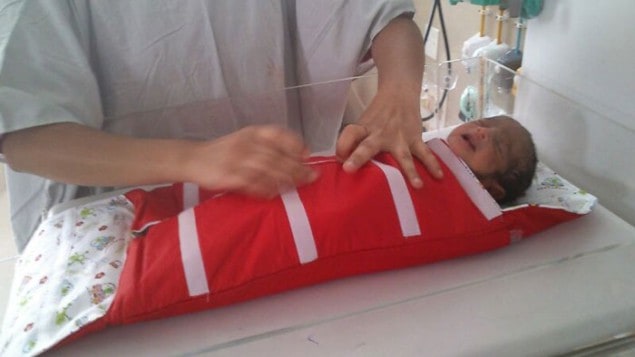
Physicists in the US are helping to develop non-electric incubating blankets, in a bid to improve the survival of premature babies and infants in developing countries. Together with start-up company Warmilu, the physicists from Kettering University in Michigan are working on blankets that are a more sophisticated version of the warming packs that can be slipped into shoes and gloves during winter. A clinical trial of a prototype of the blanket is being conducted in Bangalore, India.
According to the World Health Organisation (WHO), hypothermia at birth is one of the most crucial factors in the mortality of newborn infants of all birth weights and ages. Unlike adults, infants and young children cannot shiver to maintain body heat; they instead rely on “non-shivering thermogenesis”, which occurs in brown fat tissue. This makes hypothermia even more of a threat to babies born with a low birth weight or pre-term infants, who have less brown fat.
Early killer
This threat is greatest in developing countries and areas with limited resources. Indeed, a report from the WHO Reproductive Health Library estimates that 99% of the 4 million babies that die each year worldwide during the neonatal period (aged 0–27 days) live in areas where hypothermia is a leading cause of mortality. Carers in such areas are currently told to use everything from plastic wrap or bags to skin-to-skin contact to prevent hypothermia from setting in. However, these methods are not guaranteed. Also, using body heat to keep the infants warm has its own complications – the mother or carer must remain with the child at all times and often cannot rest through the night. According to UNICEF, preventing and managing hypothermia can help reduce neonatal mortality or morbidity by 18–42%.
Futuristic warming tech
To address these problems, entrepreneur Grace Hsia was keen to come up with a way of keeping infants warm and at a steady temperature through the night (or for at least five hours) without using electricity. To do this she set up Warmilu and is the startup’s chief executive. Inspired by warming packs, the company has developed what it describes as “an advanced phase-change materials-warming technology platform”. The packs start as a liquid, which crystallizes to a solid in seconds when the user presses a metal disc at the corner of the pack. As of now, the pack can keep warm for about five hours. It can be reused simply by boiling it for 15 minutes or heating it in a microwave for 6–12 minutes. While this is already a promising technology, Warmilu aims to make its packs last for up to eight hours, so users can keep warm through the night. The company also wants to achieve the perfect temperature to keep a newborn warm, without the pack ever getting too hot.
To help achieve this, Warmilu has partnered with physicists Uma Ramabadran and Gillian Ryan at Kettering University in Flint, Michigan. “We are trying to see how to extend the time,” says Ramabadran, adding that they “want to see if the caregiver can get a break throughout the night for at least eight hours”.
The warming pack itself is a polymer pouch that contains sodium acetate trihydrate. “You have this super-saturated liquid which is liquid below its freezing point,” says Ryan. “You cool it down and, as it turns into a crystal, it solidifies and releases heat. We want to slow down the process in which this pack forms into a crystal. You don’t want it to spontaneously form at once and have a flash in the pan. You want it to gradually crystallize so it releases heat over a longer period of time.”
Warmer for longer
The duo is exploring how it may be possible to slow down the liquid-to-solid phase transition, by studying the crystal growth pattern of the liquid. “The material grows radially out in a shallow dish, so we can film the growth of the crystals to see how we can block that and make it slower,” says Ramabadran, who explains that studying crystal growth can be a complicated business. As the material is polymorphic, it does not crystallize the same way every time – the process depends on external factors such as temperature and humidity.
To carefully access the crystal growth, Ramabadran and Ryan are using X-ray diffraction to study the crystal’s atomic structure and X-ray photoelectron spectroscopy to determine the exact chemical composition of the crystallized structure that forms. They hope to modify the structure by inserting nanoparticles into the fluid, thereby extending the warming life of the packs.
Warmilu is currently testing its incubated blankets in villages in India – a country that has one of the highest infant mortality rates in the world, partly due to the lack of electricity in rural villages. The company has sold more than 200 of its warming packs – which can be used for other purposes such as to ease joint pain – to consumers worldwide since 2013. The company charges consumers in the US nearly twice as much as those in poorer countries, to subsidize the costs.



